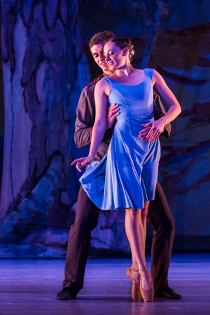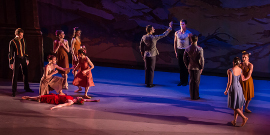 After two years of Love Stories for its Valentine's Day production, Ballet Quad Cities changed things up this year by presenting Carmen, the story of a commanding woman who does what she pleases with men she fleetingly fancies. As with Love Stories, though, there was more than one piece performed this past weekend, with choreographer Margaret Huling's "Black Coffee" - a jaunty, jazzy number also featured in last year's Love Stories: Love on the Run - making up the first portion of the evening's entertainment.
After two years of Love Stories for its Valentine's Day production, Ballet Quad Cities changed things up this year by presenting Carmen, the story of a commanding woman who does what she pleases with men she fleetingly fancies. As with Love Stories, though, there was more than one piece performed this past weekend, with choreographer Margaret Huling's "Black Coffee" - a jaunty, jazzy number also featured in last year's Love Stories: Love on the Run - making up the first portion of the evening's entertainment.
Huling's dance, set to "music reminiscent of Ray Charles and Miles Davis," featured eight members of the ballet company performing a piece that was more complexly frenetic than graceful. There was a captivating intricacy in the way Huling directed the dancers to move from one sharp position to another, with crooked arms held aloft, then sweeping in arcs to lower positions, with ever-so-slight hesitations before each new statuesque stance.
While I found Huling's choreography engaging, it felt marred by seeming uncertainty, as most of the company moved as if in anticipation of the next position rather than dancing "in the moment." While Huling put together a blend of oftentimes out-of-sync movements, there were also times when her "Black Coffee" was in sync - at least by design, considering the company as a whole, when the piece called for it, was rarely physically cohesive. While this did not destroy the piece, it did leave the dance feeling somewhat sloppy.
Jill Schwartz, though, stood out not only for being the sole dancer dressed in all black (rather than wearing black pants with a coral top), but also for her combination of beautiful technique and musicality in her movements. She managed to execute each position with full commitment, as if her current stances were all that mattered until the next one came along. Through her artfulness, Schwartz did justice to Huling's choreography, adding elegance to the imaginative frenzy.
 Huling had her chance to shine as a dancer, too, in the second half of the program, portraying the titular character in choreographer Deanna Carter's Carmen, set to music by Georges Bizet and Rodion Shchedrin. Adorned in a vibrant red, knee-length, halter-top dress, Huling first appeared alone in a sultry stance behind a translucent scrim painted to look like a Spanish countryside. (Local theatre companies could actually learn a thing or two from Ballet Quad Cities about the transformative effectiveness of a well-painted backdrop.) Holding her imperious stance, it was clear even before she moved what kind of gypsy Huling was creating: a lusty vixen in charge of her own destiny. Following a puff on a cigarette - which set the scene as outside a cigarette factory where military police flirt with female workers after their shifts - Huling commanded attention with a domineering demeanor that was present throughout the performance. Whether or not she was taller than the rest of the dancers, Huling seemed heads and shoulders above the rest, if only because of the self-certainty she wore as Carmen.
Huling had her chance to shine as a dancer, too, in the second half of the program, portraying the titular character in choreographer Deanna Carter's Carmen, set to music by Georges Bizet and Rodion Shchedrin. Adorned in a vibrant red, knee-length, halter-top dress, Huling first appeared alone in a sultry stance behind a translucent scrim painted to look like a Spanish countryside. (Local theatre companies could actually learn a thing or two from Ballet Quad Cities about the transformative effectiveness of a well-painted backdrop.) Holding her imperious stance, it was clear even before she moved what kind of gypsy Huling was creating: a lusty vixen in charge of her own destiny. Following a puff on a cigarette - which set the scene as outside a cigarette factory where military police flirt with female workers after their shifts - Huling commanded attention with a domineering demeanor that was present throughout the performance. Whether or not she was taller than the rest of the dancers, Huling seemed heads and shoulders above the rest, if only because of the self-certainty she wore as Carmen.
In contrast, Schwartz maintained a softer, more virginal take on Michaela, the true love and betrothed of the story's hero, Don José, portrayed here by Patrick Green. The sort of love triangle that unfolded, with Don José engaged to Michaela but smitten by Carmen, lent itself to showcasing Carter's range as a choreographer. In Don José's and Michaela's pas de deux, the movements were fluid and graceful, with a softness appropriate to their young love. On Friday, there was this especially simple yet beautiful moment in which Schwartz leaned against Green with her back to his chest, he lifted her, and she moved her legs as if gently peddling a bicycle while he moved across the stage. The imagery was stirring, as if Schwartz were dancing on air, with Michaela held aloft by Don José's love.
For the pas de deux between Don José and Carmen, Carter used almost violent movements much harsher than those in the man's duet with Michaela. There was a lusty forcefulness to the dance, as though the two were sharing a particularly physical sexual encounter, and to heighten the sense of sensuality, Green removed his shirt at the scene's start, revealing a sweaty, lean, muscular torso. Green not only shed his clothing, but also his inhibitions, shining in his balletic ability interpretively rather than just technically. This abandon to the art carried through to the ballet's tragic end, in a scene rendered with deep emotion. Cast aside by Carmen due to her interest in another man, Don José stabbed her, confessed the murder to the gathering crowd, and was then shot by a firing squad with his body falling in slow motion, ending the story of Carmen and Ballet Quad Cities' compelling telling of it.
For more information on Ballet Quad Cities' 2014 season, call (309)786-3779 or visit BalletQuadCities.com.










